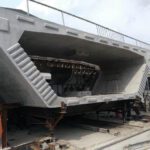Structural Functionality Evaluation Based on Natural Frequency Measurement.
The technique of structural functionality evaluation based on natural frequency measurement is used to evaluate the dynamic behaviour and structural integrity of a structure. The natural frequency is the frequency at which a structure resonates in response to an external force or disturbance. This section describes how this evaluation procedure operates.
Natural Frequency: Each structure’s modes of vibration are associated with a set of natural frequencies. These frequencies are determined by structural stiffness, mass distribution, and boundary conditions, among other variables. Each mode corresponds to a distinct vibrational pattern.
Measurement setup:To evaluate structural functionality based on natural frequencies, sensors such as accelerometers or displacement transducers are strategically located on the structure. These sensors measure the structural response to an excitation, which can be induced by striking the structure or an external vibration source.
Frequency analysis:The measured data is then subjected to frequency analysis techniques, such as Fast Fourier Transform (FFT), to determine the dominant frequencies, present in the structural response. The structure’s fundamental frequencies can be identified as peaks in the frequency spectrum.
Mode Shape Extraction:In addition to identifying the natural frequencies, the measured response also permits the extraction of mode structures. Mode shapes illustrate the movement and deformation patterns associated with each natural frequency and provide insight into the structure’s dynamic behaviour.
Comparison and evaluation:The measured natural frequencies and mode shapes are contrasted to the expected behaviour based on the structural design or theoretical calculations. Significant deviations or discrepancies may indicate structural degradation, stiffness changes, or other problems with the structure’s integrity.
Interpretation and analysis:Structural engineers interpret and analyze the data, considering variations in natural frequencies, mode shapes, and damping characteristics. This analysis identifies potential issues, such as structural deterioration, material deterioration, and structural modifications that may impact the structure’s functionality and safety.
Recommendations and Corrective Actions:Based on the evaluation’s findings, pertinent recommendations can be formulated to resolve any identified issues. These recommendations could involve restorations, retrofitting, strengthening measures, or additional research to ensure the structural functionality and integrity.
Importantly, natural frequency measurement is one of several techniques used for structural evaluation, and its interpretation necessitates knowledge of structural dynamics and vibration analysis. Typically, the results of this evaluation method serve as an indication of the structural condition and may be supplemented by additional tests and inspections for a comprehensive evaluation.
Disclaimer: This content is provided solely for your review. Erusu Consultants takes no liability for this article. The reader is advised to form their own opinion. Please consult a structural engineer before making any final decisions.






